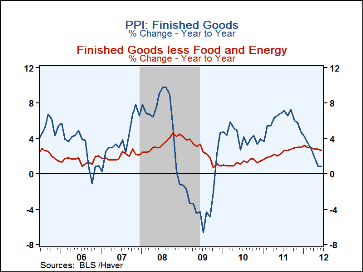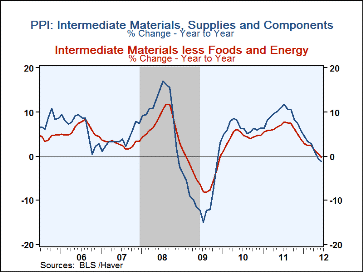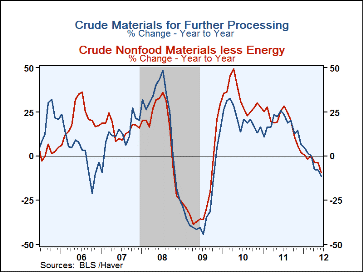 Global| Jul 13 2012
Global| Jul 13 2012U.S. PPI Unexpectedly Gains; Core Is Stable
by:Tom Moeller
|in:Economy in Brief
Summary
The producer price index for finished goods ticked 0.1% higher last month following a 1.0% May decline. Consensus expectations were for a 0.4% decline. Despite the gain, the PPI rose just 0.8% during the last year, the weakest since [...]
 The producer price index for finished goods ticked 0.1% higher
last month following a 1.0% May decline. Consensus expectations were for a
0.4% decline. Despite the gain, the PPI rose just 0.8% during the last
year, the weakest since October 2009. The PPI less food & energy rose
an expected 0.2% for the fourth consecutive month. During the twelve
months core prices rose 2.6%, the least since last July.
The producer price index for finished goods ticked 0.1% higher
last month following a 1.0% May decline. Consensus expectations were for a
0.4% decline. Despite the gain, the PPI rose just 0.8% during the last
year, the weakest since October 2009. The PPI less food & energy rose
an expected 0.2% for the fourth consecutive month. During the twelve
months core prices rose 2.6%, the least since last July.
A 0.5% increase (2.8% y/y) in finished food prices provided the lift to last month's PPI. Gains were not, however, broad-based amongst commodity groupings. Energy prices fell 0.9% (-5.5% y/y) reflecting an 8.3% decline (-5.2% y/y) in home heating oil prices and a 2.1% drop (-1.3% y/y) in electric power costs. Offsetting these declines was a 1.9% rise (-4.8% y/y) in gasoline prices. (Not seasonally adjusted gasoline prices fell 4.8% m/m.)
Finished consumer goods prices were unchanged (0.3% y/y). Less food & energy, consumer goods prices rose 0.3% (3.3% y/y). Within the components, men's apparel prices rose 5.2% y/y while women's clothing costs increased just 0.5% y/y. Household appliance prices rose 5.0% since June of 2011, furniture prices gained 2.9% y/y and passenger car prices increased 0.6 % y/y. Capital equipment prices gained just 0.2% last month and by 1.9% year-to-year.
Intermediate goods prices fell 0.5% (-1.2% y/y). Energy costs slipped 0.2% last month and by 5.4% y/y but food prices increased 1.0% (2.5% y/y). Core-intermediate prices fell 0.7% and slipped 0.3% y/y. Crude materials prices fell 3.6% last month and were down 11.6% year-to-year. Energy prices declined 5.1% (-20.5% y/y) while food prices were down 1.6% (-3.5% y/y). Prices less food & energy dropped 4.0% and were down 9.4% over the prior twelve months.
The PPI data are contained in Haver's USECON database with further detail in PPI and PPIR. The expectations figures are available in the AS1REPNA database.
| Producer Price Index (%) | Jun | May | Apr | Jun Y/Y | 2011 | 2010 | 2009 |
|---|---|---|---|---|---|---|---|
| Finished Goods | 0.1 | -1.0 | -0.2 | 0.8 | 6.0 | 4.2 | -2.5 |
| Less Food & Energy | 0.2 | 0.2 | 0.2 | 2.6 | 2.4 | 1.2 | 2.6 |
| Food | 0.5 | -0.6 | 0.2 | 2.8 | 6.3 | 3.9 | -1.4 |
| Energy | -0.9 | -4.3 | -1.4 | -5.5 | 15.7 | 13.6 | -17.6 |
| Intermediate Goods | -0.5 | -0.8 | -0.5 | -1.2 | 9.1 | 6.4 | -8.4 |
| Less Food & Energy | -0.7 | -0.2 | 0.2 | -0.3 | 6.2 | 4.3 | -4.2 |
| Crude Materials | -3.6 | -3.2 | -4.4 | -11.6 | 17.4 | 21.4 | -30.3 |
| Less Food & Energy | -4.0 | -1.3 | -1.8 | -9.4 | 18.5 | 32.5 | -23.3 |
Tom Moeller
AuthorMore in Author Profile »Prior to joining Haver Analytics in 2000, Mr. Moeller worked as the Economist at Chancellor Capital Management from 1985 to 1999. There, he developed comprehensive economic forecasts and interpreted economic data for equity and fixed income portfolio managers. Also at Chancellor, Mr. Moeller worked as an equity analyst and was responsible for researching and rating companies in the economically sensitive automobile and housing industries for investment in Chancellor’s equity portfolio. Prior to joining Chancellor, Mr. Moeller was an Economist at Citibank from 1979 to 1984. He also analyzed pricing behavior in the metals industry for the Council on Wage and Price Stability in Washington, D.C. In 1999, Mr. Moeller received the award for most accurate forecast from the Forecasters' Club of New York. From 1990 to 1992 he was President of the New York Association for Business Economists. Mr. Moeller earned an M.B.A. in Finance from Fordham University, where he graduated in 1987. He holds a Bachelor of Arts in Economics from George Washington University.








